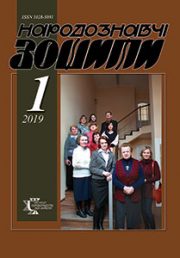The Ethnology Notebooks. 2023. № 1 (169), 257—262
UDK 801.8:[929(477):39-051]
DOI https://doi.org/10.15407/nz2023.01.257
SHALAK Oksana
- ORCID ID: https://orcid.org/0000-0002-8275-6703
- Cand. Sc. (Philology),
- Senior Research Officer,
- Institute of Biographical Studies
- National Library of Ukraine named after V.I. Vernadskyi,
- Department of theory and methods of biobibliography,
- 62 Volodymyrska vul, 125 room, Kyiv, 01033, Ukraine,
- Contacts: e-mail: shalak@ukr.net
Abstract. The relevance of the article is conditioned by the need to develop mechanisms and models for a more complete disclosure of the biographies of folklorists and talented respondents, which will allow a deeper understanding of the history of Ukrainian folkloristics. The biography of a scientist depends not only on his education, knowledge, scientific views, belonging to a scientific school. It is also determined by the conditions under which a personality is formed, socio-political circumstances that contribute to the development of his talent or inhibit it, and the development of his scientific and worldview principles. Biography becomes a part of history, and not only the history of science. Highlighting the life and scientific path is, first of all, the search for scientifically reliable sources that make it possible to determine cause-and-effect relationships, to establish the role of the folklorist in the development of science. The goal is to clarify the meaning of folklore passportization, the role of the folklore passport as a handwritten document — a scientifically reliable source for reconstructing the biographies of folklorists, their correspondents, as well as informants — individual bearers of folklore. The scientific novelty lies in the author’s desire to shed light on the history of the passportization of a folklore sample, to analyze the passports in the manuscripts of folklorists belonging to different periods in the history of Ukrainian folkloristics, as well as to reveal the significance of the passport as a kind of biographical source that contains not only the personal data of the informant, but also information about place, date of recording and name of recorder. In the 19th century passports were incomplete and sporadic, however, even in this form, they became documents that reveal certain milestones in the biographies of folklorists and informants: storytellers, singers, connoisseurs of proverbs, sayings, riddles — oral tradition in general. The methodological basis is the principle of historicism, the comparative-historical method, as well as the functional-systemic approach to the study of phenomena and personalities in the history of Ukrainian folkloristics.
Keywords: passporting, folklore sample, recorder, informant, respondent, biography, reconstruction, biographical source, manuscript, history of folkloristics.
Received 4.01.2023
REFERENCES
- Shalak, O.I. (2022). Folklore Sample Passport As a Source for Biographies of Folklorist. Іn Library. Science. Communication. Proceedings of the International Scientific Conference (Pp. 472—474). Kyiv: VNLU [іn Ukrainian].
- Dei, О.І. (Ed.). (1974). Ukrainian folk songs recorded by Zorian Dolenga-Khodakovsky. Kyiv: Naukova dumka [in Ukrainian].
- Siemienski, L. (1845). Polish, Russian, Lithuanian retelling and legends. Poznan [in Polish].
- Shalak, O. (2007). Letters of A. Dyminskyі to O. Kistiakivskyi. Folk art and ethnology, 2, 59—69 [in Ukrainian].
- Letter of A. Dyminskyi to O. Kistiakivskyi. Archive of the Institute of Manuscript of Vernadsky National Library of Ukraine. F. 1. Od. save 24871 [in Russian].
- (1875). Notes of the South-Western Department of the Imperial Russian Geographical Society (Vol. 2). Kiev [in Russian].
- (1875). The program of the South-Western Department of the Imperial Russian Geographical Society for collecting data on ethnography. Kiev: Typography of M.P. Fritz [in Russian].
- Records of folk prose. Archive of the Institute of Manuscript of Vernadsky National Library of Ukraine. F. 1. Od. save 1525 [in Ukrainian].
- Borzhkovskij, V. (1889). Lyre players. Kievskaia starina, 9 (Vol. ХХVІ, pp. 653—708) [in Russian].
- Buchko, N.O. (1959).From M.M. Kotsyubynskyi’s interests in folklore and ethnography. Folk art and ethnography, 3, 74—77 [in Ukrainian].
- Where did the lordship come from (story). Recorded by M.M. Kotsyubynskyi in the village Stadnitsy, Podilska province, in 1890. Archive of the Institute of Manuscript of Vernadsky National Library of Ukraine. F. 170. Od. save 634 [in Ukrainian].
- Household songs recorded by a student of the 4th group V. Parasunka in 1919. Archive of the Shevchenko Institute of Literature of the National Academy of Sciences of Ukraine·Department of Manuscripts and Textual Studies. F. 28. Od. save 324 [in Ukrainian].
- Sorokina, S., Zavalna, O. & Radiievska, T. The Museum of Pre- and Early History in Kyiv (1942—1943): structure and personnel. Retrieved from: https://shron1.chtyvo.org.ua/Sorokina_Svitlana/Muzei_do-_i_rannoi_istorii_u_Kyievi_1942_1943_struktura_ta_personalnyi_sklad.pdf?PHPSESSID=7q8f24pf4hb84qjv7eitj3aog5 (Last accessed: 29.11.2022).
- Korzh, N.L. (1842). Oral narrative of the former Zaporozhian Cossack, resident of the Yekaterinoslav province and district, the village of Mikhailovka, Nikita Leontyevich Korzh. Оdessa: City Typography [in Russian].
- Stadnicka, L. (Ed.). (1888). Wedding songs and rites of the Ukrainian people from the vicinity of Nemirov in Russian Podil.A collection of news for national anthropology published by the Anthropological Commission of the Academy of Arts and Sciences in Krakow (Vol. ХІІ, pp. 103—116) [in Polish].
- Venhrzhenovskіj, S. The pagan custom in the Bratslav region «chasing a shulyak». Kievskaia starina, 9, 282—323 [in Russian].






